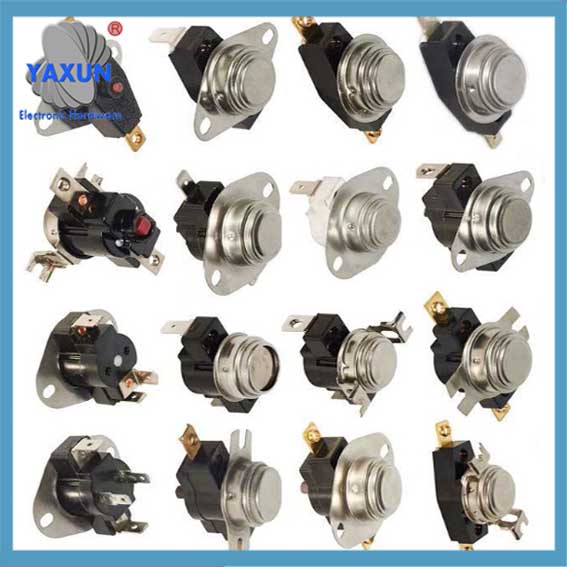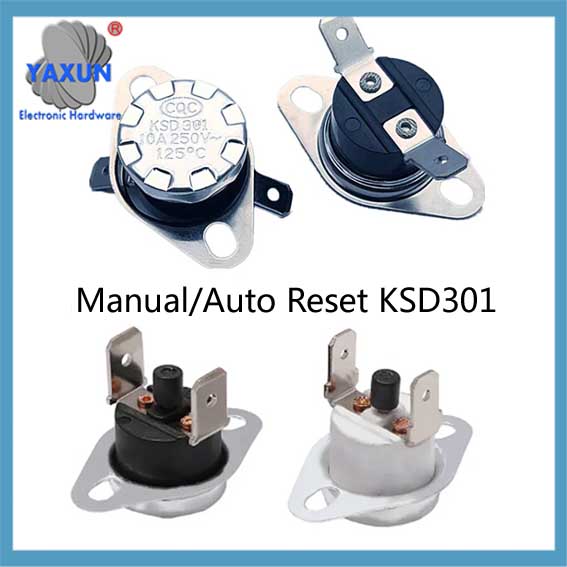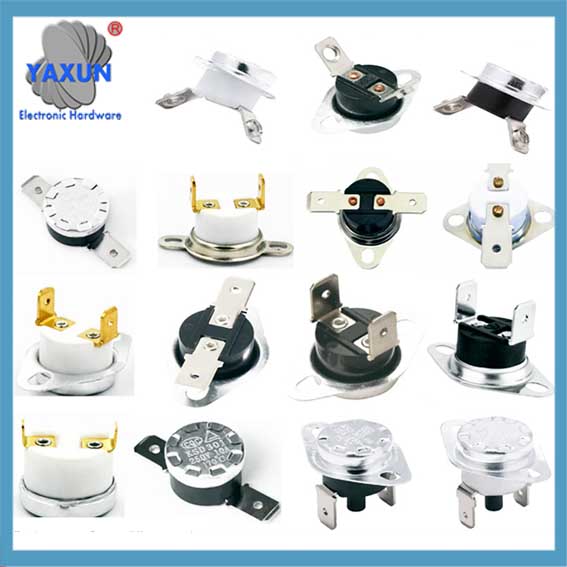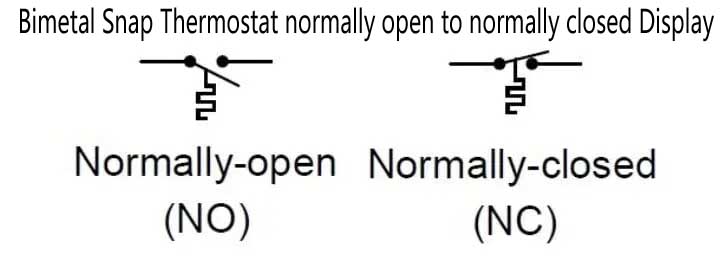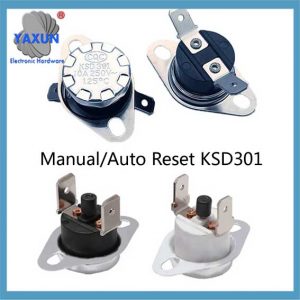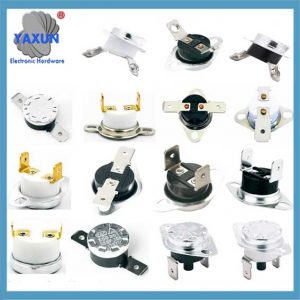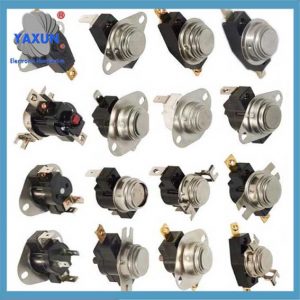Product Categories
Product Tags
Bimetal Disc Limit Thermostats: Types, Working, Applications
What is a Bimetal Disc Limit Thermostats?
Bimetal disc limit thermostats or temperature switches are those switches that change their position from normally open to normally closed (manual / auto reset) when a specific temperature is reached. This switch is helpful in managing and controlling temperatures in manufacturing and other industrial processes.
Disc Limit Thermostats are thermal protector switches that alternate between different states, options, or functions. Many types of disc switches are available, each serving a specific function. One such disc limit thermostats that has gained significant attention is known as a thermal switch.
These thermal protector switches are employed in various industries like foodstuffs, pharmaceuticals, and automotive engineering. The purpose is to maintain safe operating conditions and prevent damage due to excessive heat.
Read on to learn more about bimetal disc limit thermostats, their working, applications, and benefits!
What is a Bimetal Disc Limit Thermostats?
Bimetal disc limit thermostats or temperature switches are those switches that change their position from normally open to normally closed ((manual / auto reset)) when a specific temperature is reached. This switch is helpful in managing and controlling temperatures in manufacturing and other industrial processes. The goal is to prevent overheating in equipment and ensure safe industrial operation. Let’s look at the symbols of thermal protector switches:
Construction of a Bimetal Disc Limit Thermostats
Here’s an overview of the construction of a thermal switch that helps you understand it better:
Construction of a Bimetal Disc Limit Thermostats
Components
Switch Case
Range Nut
Range Spring
Main Spindle
Bellows
Capillary
Temperature Sensing Bulb
In the Temperature-Sensing Bulb, a specific fluid notices temperature variations and responds to them. As the temperature in the bulb increases, there’s an increase in pressure within the bellows, resulting in their compression.
Now, the spindle moves up until the spring’s force and the pressure on the bellows are in equilibrium with each other. The result is either an ON or OFF position, depending upon the switch’s set point.
Working Principle of Bimetal Disc Limit Thermostats
Below is the general overview of the working of a thermal or Bimetal temp switch:
Just like a typical switch, a bimetal temperature switch has temperature-sensitive contacts. When the temperature inside the thermal protector switch increases or reaches a specific threshold due to heat generated by the surrounding environment or the equipment itself, the contacts open quickly.
This prevents excessive heat from damaging the equipment. In contrast, when the temperature goes below the set point, the contacts close, completing the circuit and allowing the switch to work again.
Types of snap action thermostat
Various types of temperature switches are available in the market, each with a varying design and working mechanism. Let’s discuss some common ones to get an idea of what suits your needs the best:
Bimeta Limit snap action thermostat
Bimetallic Disc or Snap Action Switches
Bimetallic Disc or Snap-Action thermostat switches are a common type of thermal control switch. These switches have two metal strips bonded together, each having a different thermal coefficient. Due to this, when the temperature increases, the strips respond differently, which causes them to bend or warp.
This bending mechanism, either to open or close contacts, results in a quick snap. That’s why these switches are also named snap switches. The benefits of Bimetallic Disc or Snap Disc Switches include their compact size and low price tag.
Thermal Reed Temp Switches
Thermal Reed Temp Switches are another type of thermal switch comprising a Reed Switch, a Thermal Ferrite, and two permanent magnets. If the temperature is lower than the Thermal Ferrite’s Curie Point, the Reed Switch contacts will stay closed.
However, as the temperature rises above the Curie Point of the Thermal Ferrite, the magnetic field surrounding the switch changes, which results in the opening of the Reed Switch contacts. These switches are fully hermetically sealed and continue to work even in challenging conditions. They are also quite reliable in sensing temperature changes.
Gas-Actuated thermostat
Gas-Actuated thermostat, or you can say vapor-tension thermostat, have a sensing bulb containing gas and a diaphragm or piston. When temperature increases, the gas inside the sensing bulb expands.
This expansion exerts pressure on the diaphragm, causing the thermostat to change its state from closed to open or vice versa. Gas-Actuated thermostats are high-quality and offer accurate results, which makes them useful for safety-critical applications.
Best Limit Snap Action Thermostat for You
YAXUN brings the best snap action thermostat for you. Here’s our top-notch product:
Bimetal Snap Action Thermostat
The YAXUN Snap Action Thermostat, especially the KSD301/ KSD302 series, is a hermetically sealed bimetal thermostat with a 1/2″ disc & Hi-Amp disc 3/4″(19mm). This switch is used in various applications, offering both automatic and manual reset options. Its electrical rating includes a maximum of 16A~60Amp at 125V AC for resistive load. On top of that, the differential range of ±1℃ or ±2℃ allows precise temperature regulation.
What truly sets this resettable thermostat switch apart from others is that its operating temperature tolerance stands at ±1℃ or ±2℃, ±5℃. For safety, this unique thermal switch features a dielectric strength of AC 1000V for 1 minute or AC 1800V for 1 second. Let’s talk about reliability – with an impressive lifecycle of 100,000 cycles for 16A, this switch serves you for years without any issues.
Benefits of Yaxun Bimetal Snap Action Thermostat
Let’s now discuss the benefits you can enjoy by investing in Yaxun’s Bimetal Thermostat:
Applications of a Bimetal Snap Action Thermostat
Thermal switches find applications in various industrial and home equipment. Some of the common applications include:
1, Due to their accurate temperature monitoring and control capabilities, Thermal cut-off switchs are used in various heating systems, including boilers, circulation pumps, air heaters, and burners.
2, In various industries, such as pharmaceuticals, automotive engineering, and food processing, Thermal cut-off switchs have extensive applications. For instance, in manufacturing a product, this switch is employed to control the temperature during the process and to ensure a quality and safe product.
3, Restaurants and home kitchens are also some areas where you can use a thermal or temp cut-off switchs. These temp switches are used in appliances like ovens, grills, or refrigerators. The purpose is to control and maintain accurate food temperature during cooking and storage to prevent any risk of overheat and spoilage. Thermal protectors are used for electric heating appliances such as water dispensers, water heaters, sandwich toasters, dishwashers, dryers, disinfection cabinets, microwave ovens, electric coffee makers, electric cookers, refrigerators, air conditioners, laminators, office equipment, car seat heaters, etc.
Difference Between temperature Switch and Thermostat
Many people often confuse a temperature switch with a thermostat, but these terms aren’t interchangeable. There are significant differences between both, and you should know them for proper usage.
The temperature switch is also known as a temperature switch, while the second name for a thermostat can be a thermometer or indicator.
A temperature switch is used for temperature sensing and protection. It detects temperature changes and activates or deactivates a circuit depending on preset temperature thresholds. In contrast, a thermostat is a device that regulates temperature by turning a heating or cooling system on or off in order to maintain the set temperature.
temperature switches are bi-stable electrochemical devices, while thermostats are good examples of closed-loop control devices.
Generally, temperature switches are classified into two types: electrical and mechanical. Meanwhile, thermostat types include programmable, non-programmable, and smart.
Temperature switches come in two main parts: a temperature-sensing element and snap-action contacts. On the other hand, thermostats feature a flange, frame, housing, and wax in a cylinder.
Buying Guide for a Temperature Switch
In case you are out there to shop for a temperature switch for your needs, you will be overwhelmed by the number of options available. Refer to the guide given below to ensure you pick the right switch without breaking the bank:
Conclusion
Bimetal Snap Thermostats are a great help in detecting temperature changes to open or close a circuit. These switches are used to prevent overheating in equipment and reduce the risk of fires. Various types of temperature switches are available in the market, ranging from bimetallic disc or snap action switches to reed and gas-actuated thermostats.
Wondering where to get high-quality Bimetal snap thermostats for your applications? YAXUN online custom Bimetal Snap Thermostats factory in China! We offer highly durable and compact Snap Action Thermostat Switches that work efficiently at a varying operating temperature.
Contact us today to explore our wide variety of snap bimetal snap thermostats!
Contact Us
Waiting for your email, we will reply you within 12 hours with valuable information you needed.
 English
English العربية
العربية Български
Български 粤语
粤语 中文(简体)
中文(简体) 中文(漢字)
中文(漢字) Nederlands
Nederlands Suomi
Suomi Français
Français Deutsch
Deutsch Ελληνικά
Ελληνικά Magyar
Magyar Italiano
Italiano 日本語
日本語 한국어
한국어 Polski
Polski Português
Português Română
Română Русский
Русский Slovenščina
Slovenščina Español
Español Svenska
Svenska ภาษาไทย
ภาษาไทย Türkçe
Türkçe Tiếng Việt
Tiếng Việt
